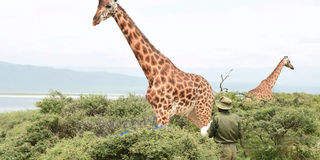Hunted: Giraffe risks being wiped out of savannah

Giraffes at Ruko Conservancy in Baringo. The giraffe has been classified as an endangered species.
What you need to know:
- It is estimated that there are approximately 32,000 Maasai giraffes in Kenya and Tanzania
- There are less than 100,000 giraffes in the wild in Africa - a 40 per cent decline in 30 years
- The population of the reticulated giraffe in Kenya, for example, has declined by 80 per cent
It is the most visible of wildlife, colourful and towering over the African Savannah.
The giraffe is one animal that is hard to miss during game drives in protected areas.
Beautiful as it is, the giraffe’s tale grows shorter and sadder with each passing day. The giraffe is either endangered or threatened. Poachers are worsening matters by targeting the animal for its meat and superstitious beliefs.
Just two days before Kenya announced the first Covid-19 case, poachers killed two white giraffes, a mother and her calf in Ijara, Garissa County. It was the first case in a series of giraffe poaching cases in protected areas that have stunned conservationists and authorities.
North Eastern is especially on the spot for increased giraffe and bush meat poaching. Two months after the white giraffes were killed, four poachers were arrested with giraffe meat in the same area in June, several days after another two people were arrested, for the same reason.
These cases are, however, not exclusive to the North Eastern region as they have also been reported in the Tsavo Conservation Area (TCA).
Truckers transporting giraffe or bush meat towards Mombasa or Nairobi, Voi, Taveta, and other towns have also been arrested, said TCA Kenya Wildlife Service senior assistant director Robert Njue.
“Amid Covid-19 and in the absence of formal jobs, people are looking for cheap protein in protected areas,” he said. “This is happening along the highway, where giraffe, dikdik and antelope meat has been seized. The cases are under investigation.”
According to Maurice Nyaligu, the African Wildlife Foundation (AWF) Landscape Programme manager, poachers are targeting giraffe for its meat for various reasons including commercial and “medical”. The results have been devastating, he said.
In the last census report, there were 4,323 giraffes in the TCA, but this number could drop due to poaching. “In some villages in Tsavo, the residents refer to a giraffe as a motorbike. They say if you kill one giraffe, you get money enough to buy a motorbike,” said Kenneth Kimitei, the African Wildlife Foundation’s landscape ecologist.
An adult giraffe weighs around two-and-a-half tonnes and on a good day, a poacher can get as much as Sh100,000 for its meat. The animals are killed using snares and guns.
To keep track of what is happening in the TCA, the foundation has been supporting a giraffe monitoring programme. AWF has been working with the Office of the Director of Public Prosecutions and the judicial officers in Wundanyi, Mwatate, Voi and Makindu law courts to stop the crimes related to giraffe and other wildlife poaching. “Averagely in a week, each of these courts receive five wildlife related cases,” said Benson Mutua, an advocate of the High Court, working for AWF in the TCA.
Besides poaching and illegal wildlife trade, the Maasai giraffe has largely been affected by habitat destruction, said Mr Njue.
Due to population increase and land conversion at the TCA, the conservation of the Maasai giraffe, one of the three species in Kenya, has been dealt a blow.
It is estimated that there are approximately 32,000 Maasai giraffes in Kenya and Tanzania. The other species - the Somali or the reticulated giraffe which are estimated to be 15,000 and the Rothschild’s giraffe and Nubian giraffe estimated to be 2,000 - are also endangered.
The latest census report by the International Union for Conservation of Nature (IUCN) shows that there are less than 100,000 giraffes in the wild in Africa. This is a 40 per cent decline in a period of 30 years. Further, giraffes are extinct in seven countries.
The population of the reticulated giraffe in Kenya, for example, has declined by 80 per cent in the past three decades.
In 2018, IUCN updated its list of endangered species and listed as “critically endangered” the Kordofan and Nubian giraffe, and as “endangered” the reticulated giraffe.



